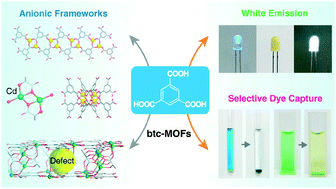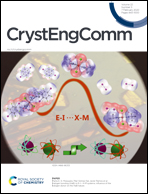A series of anionic MOFs with cluster-based, pillared-layer and rod-spacer motifs: near-sunlight white-light emission and selective dye capture†
Abstract
Ionic MOFs are rare but function in an interesting manner due to charged frameworks and the existence of counter ions in the channels. Using one of the most simple and cheap ligands of benzene-1,3,5-tricarboxylic acid (H3btc), we constructed five novel anionic MOFs namely [Me2NH2][Cd(btc)]·0.5DMA·2H2O (1), [Me2NH2]2[Cd5(btc)2(lac)3(H2O)3]·4DMF (2, H2lac = 2-hydroxypropanoic acid), [Me2NH2][MnII(btc)]·DMA (3), [Me4N]3[MnII3(btc)2(Hbtc)(CH3COO)]·9CH3OH (4) and [Me2NH2]2[Zn5(btc)4(DMA)2]·5.5DMA (5). Rich structure variabilities including cluster-based, pillared-layer and rod-spacer motifs were found in these MOFs because of the different metal coordination and effect of auxiliary ligands. 1 was a [Cd2(COO)4]-based porous framework belonging to (3,6) connected α-PbO2 net. 2 was a [Cd(btc)]-layers and [Cd2(lac)2] pillar-based framework, which possessed rare-ordered defects due to the self-absence of 25% pillars. In 2, for the first time, extremely rare square-planar Cd(II) geometry in porous MOFs was found. 3 was the first 3D framework constructed from unusual Mn–carboxyl chains with [Mn2(COO)2] building blocks. 4 provided a new example to construct a pillared-layer framework from self-assembled metal–ligand chains as pillars. 5 had a [Zn2]-cluster-based framework with dual pore systems of 1D rounded channels and elongated cages. A new single-phase white-emitting phosphor of 1 was found, which exhibited near-sunlight and human vision friendly broadband spectrum, with extremely large full width at half maximum (FWHM) of up to 268 nm, close pure white chromaticity coordinates of (0.303–0.317, 0.354–0.364), near daylight color temperature of 5773–5899 K, as well as high color rendering index of 90. In comparison, 2, 3 and 4 showed single and narrow blue emission. Rapid and selective capture of methylene blue (MB) over methyl orange (MO) was realized in 1, while MB adsorption in other MOFs was negligible.



 Please wait while we load your content...
Please wait while we load your content...